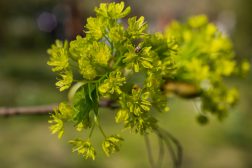Definition
noun
A pan-tropical genus of trees, shrubs, or vines belonging to the taxonomic family Moraceae
Supplement
Moraceae is a taxonomic family of the order Rosales of the kingdom Plantae. It is also called the mulberry family or the fig family. There are five tribes of the family Moraceae: (1) Artocarpeae, (2) Castilleae, (3) Dorstenieae, (4) Ficaea, and (5) Moreae. They are primarily characterized by the presence of lacticifers (i.e. an elongated secretory cell in leaves and stems of plants producing latex and rubber) and milky sap in parenchymatous tissues.
The tribe Ficaea includes only one genus, i.e. Ficus. This genus is characterized by having large, thick, or stiff leaves. Many of them are evergreen. Members of this genus are characterized by their unique inflorescence and pollination system (i.e. involving a specific wasp species (i.e. fig wasp of the family Agaonidaeas pollinators). Many of them produce aerial roots. Their fruit is an enclosed inflorescence (i.e. syconium). All figs possess a white to yellowish latex.
There are about 800 species belonging to this genus. Examples are F. carica (known as the common fig), F. indica (commonly known as the banyan tree), F. religiosa (also known as the peepul tree), F. elastica (commonly known as the India rubber tree).
They are ecologically and economically important as food such as F. carica fruit that are commercially available for human consumption.
Word origin: Latin fīcus (“fig”)
Scientific classification:
- Kingdom: Plantae
- Order: Rosales
- Family: Moraceae
- Tribe: Ficeae
- Genus: Ficus
See also:







